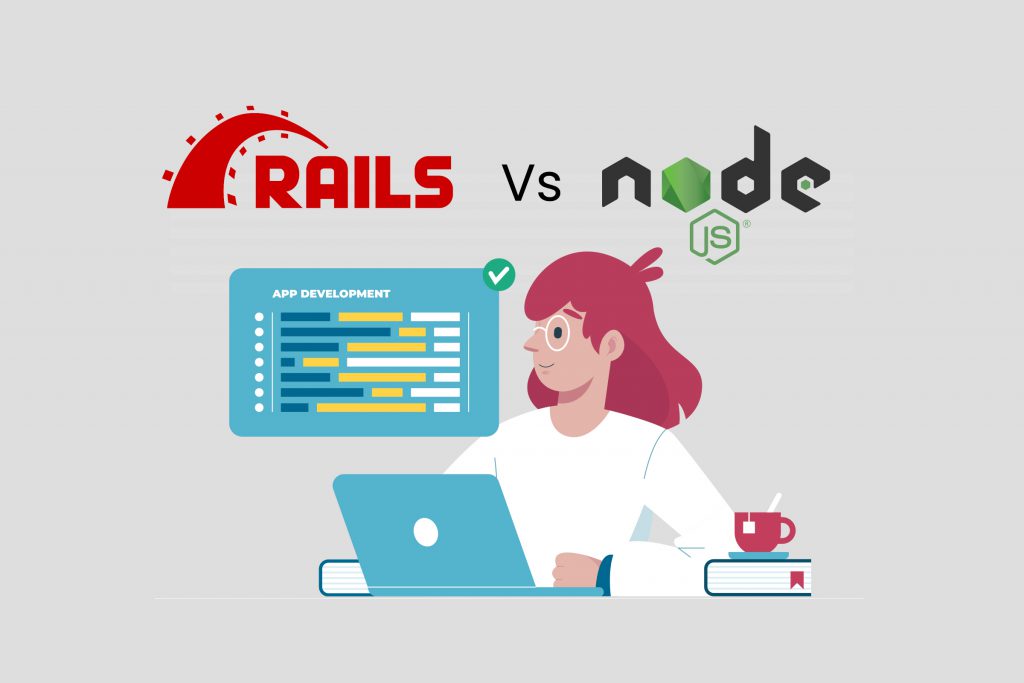If you’re looking into developing an app or reconfiguring your existing website, like millions of businesses, one of the first decisions is what type of technology to choose.
Ruby on Rails developers use the Ruby language and love the speed and simplicity as a time-saver for complex tasks with tons of tools to debug code. Node.js is a lighter-weight environment with greater agility, meaning it has smaller modules, making it easier to manipulate and scale up or down.
Today we’ll compare Ruby on Rails to Node.js in order to give you an idea about which developers to hire and the development framework most suited to your requirements.
The Pros and Cons of Ruby on Rails
Ruby on Rails is a web development framework and the backend behind countless applications.
What is Ruby on Rails used for? Primarily, a developer might use Rails for creating an app with lots of image processing or graphics, where they need a framework that can handle heavy CPU-intensive jobs.
It has the functionality to produce finished apps faster without endless repetitive code so that a developer can get a Minimum Viable Product (MVP) to market quickly.
Ruby on Rails: The Advantages
- Full-stack backend framework: code in Rails is super organized, and although your developer needs to invest a bit of time into initiating the MVC (Model, View, Controller) framework route, it’s easy to read and low on maintenance.
- Competitive CMS advantages: PHP is still the top choice for content management systems (CMS), but Rails is giving it a run for its money. Tools allow developers to write rich functionality with minimum code and concise mapping instructions to streamline each task.
- Simple prototyping: the ecosystem comprises multiple built-in features with command-line builders, so a developer won’t have to write all the code from scratch and can mock up an efficient app in no time.
Ruby on Rails: The Downsides
The headache with Ruby on Rails is that the framework isn’t nippy–if we’re honest, it can be downright slow if we look at the newest version next to Node.js.
Developers can build an application faster, but the performance delays are down to slower hardware code interpretation and Just in Time (JIT) compilation. JIT skips conversion steps to boost performance speed, turning JS code into by codes rather than machine language; Rails has only incorporated JIT in recent versions, and it’s not quite on point yet.
The Pros and Cons of Node.js
Node.js is a different beast and uses JavaScript (JS) instead of Ruby as a development language. It offers great performance speeds and is ideal for real-time apps like chat rooms or games–but there are a few pros and cons to consider here, too!
Node.js: The Advantages
- Reliable server-side communications: developers can simultaneously use JS at the front and backend and establish a reliable dialogue between the browser and server using a long-polling technique.
- Suited to REST API development: REST (Representational State Transfer) allows users to receive web request outputs quickly, engineered for on-demand responsiveness.
- Compatible microservices architecture: the non-blocking request algorithms mean developers can connect with numerous services, processing significant volumes of requests with fast data processing speeds.
Node.js: The Downsides
JS is widely used as a programming language, so any developer who understands JS for frontend development won’t have any trouble learning it for backend use. The complication is that JS is designed as a frontend tool and isn’t adapted to every aspect of server-side development.
Node.js compensates for this drawback, but it’s not perfect. The single-thread language processes one request at a time unless the developer can create an event series. Node.js executes operations rapidly but needs a solid logical process to avoid becoming overburdened.
A large ecosystem is a bonus for reusable code, add-ons, and plugins for versatility, but npm packages (readymade components) can be a serious security risk.
Conclusion
There isn’t a universally preferable framework, because the correct tech for your applications depends entirely on what you want them to do and how they work.
As a cheat sheet:
- Ruby on Rails is great for building something fast, relying on standard conventions rather than a highly customized app.
- Node.js is better suited to real-time apps, where you need to process a substantial amount of data flowing between your user and the server (think messaging, video calls, or workplace collaborations).
Our advice is to speak with a skilled developer with the knowledge and expertise to guide you through the decision-making process. If you have an outline of what your perfect app will look like, it’ll make it easier to determine the best technology to make it happen.



